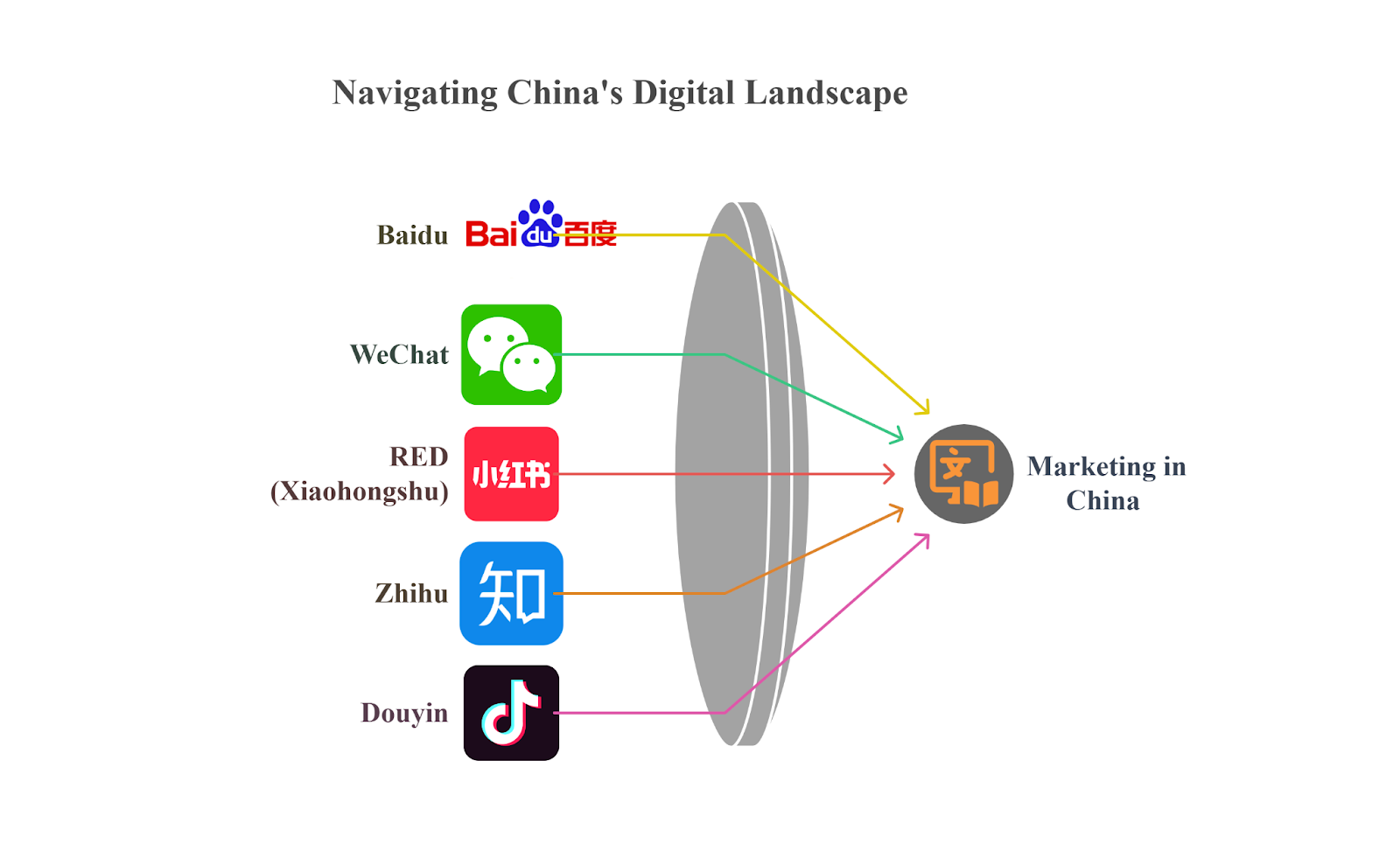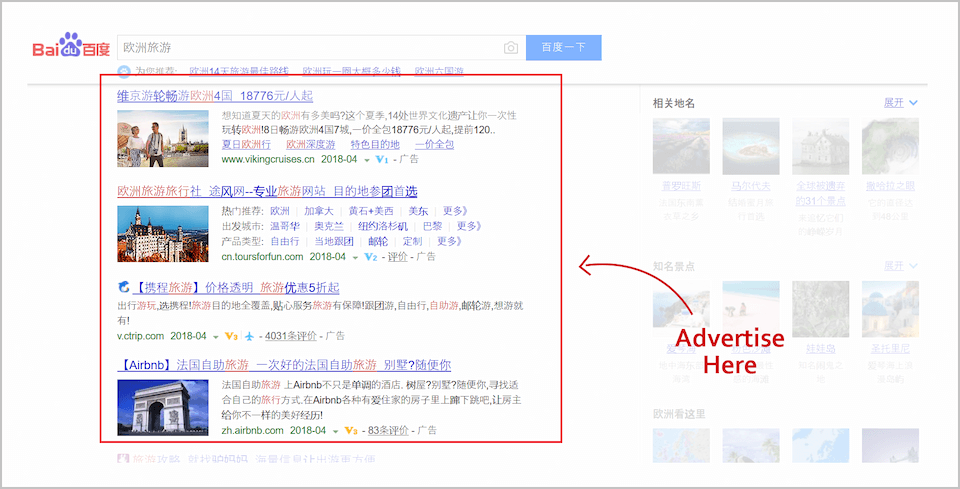Marketing In China Vs US: What Western Business Needs To Know About Baidu
Imagine trying to market your business in a world where Google, LinkedIn, and Facebook don’t exist. That’s exactly what it feels like when Western businesses enter China’s digital landscape for the first time. The platforms are different. The rules are stricter.
And the expectations? Much higher.
This blog is your essential guide to understanding marketing in China vs the US, not in vague terms, but through the lens of what matters, including platforms, buyer psychology, and practical strategy.
At the center of it all is Baidu, China’s dominant search engine and your most powerful gateway to building visibility and trust. Whether you’re in B2B software, education, logistics services, or marketing manager exploring China, this blog will show you how marketing in China works, why Baidu plays a central role, and how to adapt your strategy for real results.
Let’s dive in and demystify what it takes to win.
China’s Digital Ecosystem: What Makes It Different
One of the first things Western businesses discover is that China’s digital ecosystem operates in a world of its own. Global platforms like Google, Facebook, and YouTube are blocked. In their place, a powerful network of Chinese platforms drives all online activity, each with its purpose.
- Baidu is China’s #1 search engine, handling over 6 billion daily queries. It dominates B2B and research-intent traffic, making it essential for companies targeting professionals, decision-makers, and institutions.
- WeChat functions as a multi-tool with messaging, e-commerce, customer service, and content all live inside its ecosystem.
- RED (Xiaohongshu) is a go-to for lifestyle discovery and reviews, think Instagram meets TripAdvisor.
- Zhihu offers deep-dive educational and thought-leadership content, similar to Quora or Medium.
- Douyin, the Chinese version of TikTok, is the top short-video platform for entertainment and influencer marketing.

Together, these platforms form a tightly regulated, mobile-first ecosystem. To succeed, your brand must integrate with them natively, starting with Baidu as the primary research and trust engine.
For Western B2B companies, Baidu isn’t just a search engine, it’s the primary research tool Chinese professionals use to assess credibility and compare options. From discovering service providers to reading in-depth articles and customer case studies, Chinese decision-makers rely on Baidu throughout the buying journey.
If your business doesn’t appear in Baidu search results with relevant, localized content, you risk being invisible to your target audience. For B2B visibility in China, Baidu advertising is your foundation.
Understanding Chinese Buyer Behavior
China’s digital ecosystem isn’t just unique, it’s completely self-contained. Due to government regulations and cultural differences, global platforms like Google, YouTube, Facebook, and LinkedIn are blocked.
Instead, Chinese consumers and businesses rely on a set of homegrown platforms such as Baidu for search, WeChat for communication, RED and Douyin for content discovery, and Zhihu for trusted Q&A. These platforms operate under strict content rules and require verified business credentials to participate fully.
Unlike in the West, where buyers often make fast, independent decisions, Chinese buyers especially follow longer, more cautious paths. Decision-making typically involves multiple stakeholders and emphasizes trust, education, and verification.
Buyers prefer to see in-depth local-language content, case studies, and clear evidence of a brand’s legitimacy in China before engaging. Also, credibility is often judged by presence on trusted Chinese platforms and a high-quality, mobile-optimized Chinese website.
Over 99% of China’s internet users are mobile-first, so a poor mobile UX can instantly reduce trust. Research from McKinsey shows that over 70% of Chinese buyers prefer to interact with content in Chinese before contacting a vendor. This highlights the critical role of transcreation, not just translation.
Here, you’ll find a breakdown of the key differences in purchasing behavior between China and the US.
| Aspect | China | US |
| Decision Speed | Slower, multi-stakeholder | Faster, often individual-led |
| Trust Factors | Local-language content, platform presence | Reviews, brand reputation, and case studies |
| Preferred Content | Educational, long-form, mobile-optimized | Concise, visual-heavy, English-language |
| Communication Style | Formal, relationship-focused | Direct, efficiency-focused |
| Language Requirement | Chinese (Simplified) | English |
Why Baidu Is the Digital Gateway for Western Brands
For Western companies entering China, establishing a credible digital presence starts with Baidu. As China’s largest search engine with over 75% market share in many B2B and service sectors, Baidu is the first place Chinese professionals go when researching products, services, and business partners.
Whether you’re offering SaaS solutions, logistics services, education programs, or specialized consulting, if your brand isn’t visible on Baidu, it simply doesn’t exist to your potential audience. What makes Baidu so powerful is not just its dominance in search, but its integration across a full-stack ecosystem. This includes:
- Baidu Search: The core platform where users search for businesses, reviews, and educational content.
- Baidu Maps: Essential for location-based services and offline trust-building.
- Baidu Zhidao and Baike: User forums and knowledge bases where B2B buyers look for peer insights and company profiles.
- Baidu News: Influence brand sentiment and visibility in both consumer and business channels.
Importantly, visibility on Baidu, especially through Baidu ads for Western companies, helps build credibility long before any direct sales conversation begins. In the Chinese market, where trust is a prerequisite to engagement, appearing in native-language search results with optimized, locally hosted content positions your brand as a legitimate player.
Baidu also prioritizes mobile optimization and locally relevant signals, making it essential to tailor your website and content accordingly. In short, for Western brands seeking meaningful growth in China’s digital economy, Baidu isn’t optional, it’s your first and most critical gateway.
Comparative Analysis Of Marketing In China Vs Us
| Aspect | United States (US) | China |
| Core Platforms | Google, Facebook, Instagram, LinkedIn, YouTube | Baidu, WeChat, RED (Xiaohongshu), Douyin, Zhihu |
| Search Engine Behavior | Direct, keyword-focused searches with global SERP standards | Longer, more conversational queries; localized SERPs via Baidu |
| SEO Strategy | Backlink quality, structured data, and global hosting | Local hosting, keyword density, and Baidu Ziyuan optimization |
| Ad Setup & Management | Self-service, fast setup via Google Ads | Manual setup, account verification, Chinese-language interface |
| Content Expectations | Short, visual-heavy, often brand-centric | Informational, educational, long-form, trust-building content |
| User Behavior | Fast decision-making, cross-platform engagement | Trust-first, platform-contained, longer research cycles |
| Mobile Experience | Mobile-friendly, but desktop remains common | Mobile-first, mobile-only UX is critical for conversions |
| Analytics & Tracking | Google Analytics, Search Console | Baidu Tongji, Baidu Ziyuan |
| Compliance & Licensing | Minimal to none for global platforms | An ICP license is required for website visibility in China |
China Is a Mobile-First Market: Why That Matters
China’s mobile dominance isn’t just a trend, it’s a foundational reality. In 2023, 99.9% of Chinese internet users accessed the web via mobile devices, with over 1.091 billion mobile users out of 1.092 billion total users.
Furthermore, early 2025 data shows China had 1.87 billion cellular mobile connections, more than 132% of its population, illustrating widespread device adoption. So, Western businesses aiming to grow in China must internalize three mobile-first truths:
- Design exclusively for mobile: Desktop-centric experiences fall flat and reduce conversions by 60–70%. Chinese consumers expect responsive, fast-loading web environments that work seamlessly on any device.
- Invest in speed: Improved connection infrastructure means Chinese users expect fast load times. Pages that exceed 3 seconds risk losing 40% of visitors before they even see content.
- Build attractive mobile UX: Clean layouts, touch-friendly CTAs, and mobile-native features like QR codes for easy WeChat integration are table stakes.
Winning Baidu Marketing Strategy For Western Brands
Transcreate a Local Chinese Website
Your first step isn’t to translate your site, it’s to transcreate it. Chinese users expect fast, intuitive, and mobile-optimized experiences with culturally relevant content. While you can retain your global brand visuals for consistency, the structure and flow of the site must cater to Chinese browsing habits. That includes:
- Simplified Chinese content written for local search intent
- Streamlined navigation aligned with user expectations
- Mobile-first design with fast load times, preferably hosted in mainland China
Beyond UX, local hosting supports Baidu SEO. China’s Great Firewall affects speed and reliability, so hosting your site closer to users ensures better indexation by Baidu’s crawlers and an improved user experience.
Launch Baidu Ads With Precision
Unlike Google, Baidu advertising requires verified business documentation, a Chinese-language setup, and strategic management. Western brands must take extra care to align ad copy with local compliance rules, especially in industries like health, beauty, and education.
The key is focusing on keyword intent in Chinese. Unlike Google Ads, where users often search with short, transactional keywords, Baidu users tend to use longer, more conversational queries. This difference in behavior highlights the importance of adapting your keyword strategy when running Baidu vs Google Ads.

Western businesses need to use native keyword tools to ensure their ads reach the right audience. Pair this with localized landing pages, and you can run high-ROI campaigns that both attract and convert.
Use Baidu Ziyuan For SEO
Think of Baidu Ziyuan as your Baidu version of Google Search Console. It offers insights into:
- Crawling frequency and issues
- Indexation status
- Keyword click and impression data

Regularly checking Ziyuan allows your team to tune performance, identify ranking opportunities, and align future content with real search behavior. Combined with Baidu Tongji (analytics), you can get a full picture of how Chinese users engage with your site and where improvements can be made.
Practical Takeaways For B2B Marketing Managers
- Avoid copy-paste translations and localize your messaging to address Chinese buyer expectations and terminology.
- Host your site in China to improve Baidu crawl speed and page load times.
- Secure an ICP license to ensure legal visibility inside China’s internet ecosystem.
- Incorporate localized trust signals, such as case studies from local clients, third-party endorsements, and Chinese contact options.
- Design your site with mobile-first principles: clear layouts, fast load speeds, and thumb-friendly navigation.
- Highlight key CTAs like “Contact Us,” “Request a Demo,” or “Follow on WeChat” prominently on mobile views.
- Ensure the entire site functions smoothly on all major Chinese mobile browsers and devices.
- Begin with a robust Baidu SEO strategy that utilizes localized keywords and content structure optimized through Baidu Ziyuan.
- Run Baidu ads to drive targeted traffic, especially effective for niche services or industrial segments.
- Track performance through Baidu Tongji to optimize campaigns and better understand how Chinese users interact with your content.
Final Words
Marketing in China vs the US isn’t about small adjustments, it’s a full strategic shift. From understanding China’s self-contained digital ecosystem to mastering Baidu’s role in visibility and trust-building, Western businesses must reorient their approach.
Baidu is more than just a search engine; it’s your launchpad for discovery, credibility, China PPC advertising, and lead generation across both B2B and B2C sectors. Whether you’re starting from scratch or looking to scale existing efforts, focusing on localized content, mobile-first UX, and Baidu advertising will help you stand out in a competitive landscape.
Want expert guidance tailored to your industry and goals? Book a free consultation call today.
